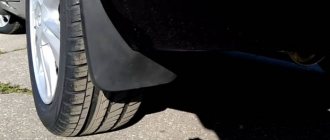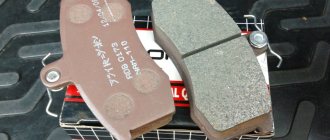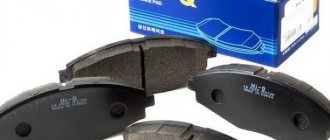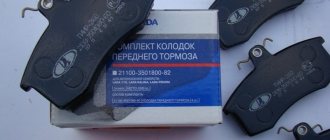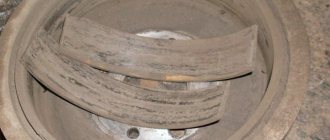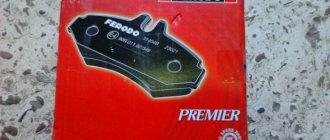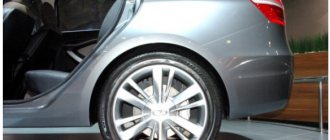Any car slows down due to the fact that the pads press the disc after pressing the brake pedal. The working brake system of a car is a complex mechanism. Front and rear pads for a Lada Vesta car are consumable spare parts that have their own resource and are only part of this mechanism. Vesta, by the way, is a car with good brakes. Because in inventive activities more attention is paid to brakes than to engine modernization - everything is done for the safety of the driver and passengers. Like all parts, the pads, especially the front ones, are not of good quality, sometimes they creak when they are cold. This is due to the quality of workmanship and not a perfect fit to the disk. Poor quality pads can quickly eat up the metal of the disc, or quickly wear out on their own. The braking distance must be minimized, even when the car is traveling at the “maximum” speed. The rear pads come in drum and front disc versions. Depending on the modification, Lada Vesta has both options. But which engine costs 1.6 or 1.8 does not affect the choice of pads at all - they are the same everywhere.
A large load when braking falls on the front pads of the car, which “catch” all the energy on themselves. Parts of the brake mechanisms (especially the front ones) wear out over time, and they wear out even faster if the driver has a jagged driving style with sharp braking to a complete stop. The front pads of the Lada Vesta are good enough to withstand full braking, but even they can be “upgraded”.
wear of the front pad in relation to the old one to the new one
The importance of the service braking system cannot be underestimated. The rear pads of the Lada Vesta experience considerable load when braking and eventually fail. The force with which a car brakes directly depends on the condition of the working brake system, including the rear pads.
RDT (Rear disc brakes) are available in the Lada Vesta SV Cross and Sport modifications. They provide greater braking effect and are more durable due to their design - they overheat less, but have a shorter service life. Drum brakes are available on other versions of the Lada Vesta; they are considered less effective when braking, but longer lasting.
Replacing rear brake pads is more difficult with a drum. The nut must be rotated carefully, otherwise the mechanism will be damaged. Combined with the care with which you have to handle the springs and small parts of the mechanism, you can say that the mechanism is rather weak, but in fact it has been tested over the years and boasts a long service life.
The rear drum mechanism with pads looks like this
Lada Vesta brake pads are recommended to be inspected after 15,000 km. According to the regulations, replacement is carried out after 60,000 km, but experts advise changing them at 30-45 thousand km.
- Standard front pads - article number and price
- What you need to replace brake pads
- Basic faults
- When to change pads on Lada Vesta according to regulations
- Removing and installing front pads
- What front brake pads can be installed on the Lada Vesta - manufacturers, analogue prices
- Rear brake pads Lada Vesta - replacement
- Replacement with calipers
- To replace the rear disc pads of the Lada Vesta you need
- How to change with drums
- What can you tell by the wear of the rear brake pads?
- Analogues on calipers and drums
Standard front pads - article number and price
On a Lada Vesta car of any modification and in any body, consumables manufactured by Renault are installed - be it a sw station wagon, sw cross, sport, etc. On the Lada Vesta St. Cross, the consumable parts can withstand the load - they wear out at the same rate as on other modifications.
Standard components of the Lada Vesta brake system received catalog number 8200 432 336. Their cost in stores starts at 1,400 rubles and ends at approximately 2,000 rubles.
Front brake pads
As with all cars, the market offers many options, among which you can easily find original parts, as well as analogues, many of which are good options.
Original
Since modern Lada models have a lot in common with budget Renault models, some of which are even assembled at AvtoVAZ factories. The front pads were no exception; they were taken from Renault Logan. Several options can be used as original pads for the vest:
- French pads from Renault with numbers: 8200432336 or 410608481R;
- “TIIR” from Yaroslavl under number 8450108101.
French versions cost a little less than two thousand rubles, and the Russian version will cost less – about 1,200 rubles.
For the Vesta Sport version, other original pads from Tolyatti from Lada Sport LLC are used under the number 8450038536. These are the most expensive of the original pads for the front axle, their cost exceeds 2,700 rubles.
Analogs
If it is impossible to purchase and install original spare parts, the manufacturer suggests using two options for front pads:
- Fortech FB1223F;
- Ferodo number FDB1617.
The first ones are very cheap, about 850 rubles, the second ones will cost about twice as much.
There are a lot of analogues, however, specific reviews that would allow you to verify good quality and full compatibility are not present on all of them.
Accordingly, choosing an inexpensive analogue is not difficult, but it would not hurt to measure the products in the store for compatibility. If we talk about options that will definitely fit, since they have already been tested by many Lada Vesta owners, then we can highlight several of the highest quality options:
- Miles number E100108;
- TRW number GDB3332;
- Remsa number 0987.00;
- HiQ Sangsin Brake number SP1564.
Resource
Pads are a spare part for which it is difficult to predict their service life, since their wear rate directly depends on the style of use of the machine. For reference, you can take the mark of 15 thousand kilometers.
Standard rear brake pads - article number and price
The article number for a set of original pads comes in two types – for drum and disc brakes. The catalog number of the kit for the VAZ Lada Vesta with disc brakes is 11196-3502089-00. It costs about 2000 rubles.
Drums
The kit catalog number for the version with drum brakes is 8450076668. It will cost 4,000 rubles, but, again, it will last longer.
Complete set with calipers
Disc brakes complete with calipers are not sold everywhere, but you can purchase additional calipers. Article - 11196350201100, cost - from 9000, produced by AvtoVAZ.
Pads and their articles for the disc mechanism of the rear brake system of Lada Vesta
AvtoVAZ installs TRW pads for rear disc brakes:
- Pad article number - GDB 1384, price ~ 1400 rubles per set
As such, there have been no complaints about these spare parts from Lada Vesta owners; we can also note the budget price tag and the relatively high quality of the pads from this manufacturer.
Therefore, we recommend purchasing pads installed at the factory. The pads on the disc brake mechanism are changed at ~20-30 thousand kilometers, this number is individual and depends on the driving style of a particular driver, so when replacing rear pads it is not recommended to focus only on mileage. When the pads wear out, you will definitely feel a deterioration in braking, and in rare cases, an extraneous sound may appear. In addition, pay attention to the operation of the hand brake; situations when the hand brake does not hold the car weakly indicate severe wear of the rear brake system.
The procedure for replacing the rear pads is not much different from the front ones, so you can use the instructions from the article on replacing the front pads. The only difference is the handbrake cable connected to the caliper, but it does not in any way interfere with the work of replacing the brake mechanism.
Lada Vesta with a 1.6 liter engine is equipped with drum brakes, as a result of which the pads and part numbers will differ. In addition, replacing them will be labor-intensive. Pads on such a system last longer than disc ones, their average service life is ~100 thousand kilometers; again, this figure varies depending on the driver’s driving style. In some cases, the pads wore out only after 200 thousand kilometers.
Basic faults
If we exclude the possible defective parts and poor quality from the manufacturer, then the main reason why the front pads on the Lada Vesta become unusable is wear. They actively interact with other parts of the brake mechanism, and therefore a look at the nature of damage to the friction linings will make it clear what is wrong with the operation of the brake system. By correcting this error, you will increase the service life of not only the pads, but also the entire mechanism.
The nature of the malfunctions can be noted:
- Uniform wear - it manifests itself in the fact that the friction layer is worn evenly, this shows that the brakes are working well.
- Severe wear of the friction layer, brake rivets are visible - this means that you have been using the “outdated” parts for too long. The rivets could damage the disc, so it would be a good idea to inspect it for damage.
- The friction layer is worn evenly around the entire circle, but one of the sides is worn out more than the other - one of the parts of the brake system (guide or piston) does not distribute the braking force correctly. Cleaning all “live” parts and applying a new layer of lubricant will help. Naturally, everything will have to change.
- Both components are worn unevenly, the surface is strewn with irregularities and roughness. The reason for this outcome is a malfunction of the caliper guide pins - they swing and do not give an even trajectory of movement. You will have to clean them, then reapply lubricant.
- The friction lining is cracked - in this case, the “trouble” is caused by the brake discs themselves - they wear unevenly. Everything will have to change.
- Uneven wear of the friction layer means that the parts were installed incorrectly. They will have to be changed.
After performing a visual inspection of the damage, you can independently make a verdict about the breakdown. And besides this, there are several other signs by which you can find out about a faulty front pad while sitting behind the wheel.
Creak
If a squeaking noise occurs from the front when braking, this means that the pad and disc are not mating. This happens when a cheap analogue was purchased to replace the original component. But not everything is so bad - sometimes this analogue can last a long time, but the real reason is dirt that has gotten into the moving parts and reduces the contact area of the moving parts.
Vibration at speed: what is it?
Vibration at speed appears when the pads do not fit the discs - there is some incompatibility that does not manifest itself in the operation of the “original” parts. If, when braking, you still get “full contact” of these parts of the brake mechanism, this means that the wear of the hub discs themselves is haunting, and they will have to be replaced.
Common problems
When using the pads, some problems arise. To check, you need to remove the rear pads on the Vesta and carefully examine them. By the appearance of the elements you can determine how worn they are:
- uniform abrasion of the friction layer indicates uniform wear;
- severe wear of the layer and the visibility of brake rivets indicate an excessively long service life;
- greater erasure of one of the sides of the circle indicates an incorrect distribution of force for braking one of the parts;
- the appearance of irregularities on the surface is a sign of a malfunction of the caliper guide pins.
- Uneven wear of the layer may indicate incorrect installation of parts; they should be replaced.
Other signs appear when moving. Usually, by sound, a car owner can understand that a particular part requires either replacement or major repairs.
Main signals about problems:
- A squeaking noise when braking occurs when the pad and disc are not mated correctly. This happens when installing an analogue or when dirt gets between the moving elements.
- The appearance of vibration at speed also indicates that the installed parts do not fit the discs.
Removing and installing front pads
Before starting work, prepare the following tools:
- Keys for 13 and 15;
- Brake system parts cleaner (a regular rag will not be able to completely remove dirt and used lubricant residues);
- Flat screwdriver;
- High temperature grease.
The procedure for replacing parts is as follows:
- Secure the vehicle in place by applying the parking brake. Turn off the ignition. Raise the front of Vesta with a jack;
- Proceed to remove the wheel. Remove the cap, loosen the bolts one turn. Continue this action in a circle with all the bolts;
- Remove the brake fluid reservoir cap and pump out a few milliliters. This will prevent the liquid from coming under pressure. Press the brake cylinder inward with a screwdriver;
- Use a 15mm wrench to hold the caliper guide pin, and use a 13mm wrench to remove the two bolts. Do not let the free part of the caliper fall to the ground;
- Pry up the outer pad with a screwdriver and carefully remove it. In the same way, remove the inner block;
- The spring retainer, which is responsible for uniform wear, will have to be cleaned and then re-coated with lubricant;
- Install a new part - first the external one, then the internal one;
- Clean the guides and also coat them with lubricant;
- Put all the parts back;
- Tighten the fastening bolts, install the wheel, clockwise, one rotation at a time, secure all the bolts.
What front brake pads can be installed on the Lada Vesta - manufacturers, analogue prices
The following analogues of front pads are common:
- Front brake pads HI-Q Sangsin Brake (SP 1564) – 1400 rubles;
- SAT (ST4106000Q0K) – 450 rubles;
- Brembo (P68033) – 1600 rubles;
- Galfer (B1G10207412) – 1250 rubles;
- Zekkert (BS-1221) – 700 rubles;
- Blitz (BB0292) – 750 rubles;
- Hagen Sangsin Brake (GP 1564) – 1400 rubles;
- UBS (BP1105007) – 1500 rubles;
- ATE (13.0460-2709.2) – 1700 rubles;
- LYNXauto (BD5739) – 850 rubles;
- TRW (GDB 3332) – 1700 rubles.
Popular products of the spare parts group - Brake pads for LADA VESTA SW station wagon (GFK_)
Brake system LADA VESTA SW station wagon (GFK_) Front brake pads Renault Clio III/Logan I/Modus/Grand Modus 04>15 Nissan Micra C+C III/Micra III/Note 03>12 FENOX BP43018
manufacturer: FENOX (Belarus) article number: BP43018
1 220 a
Brake system LADA VESTA SW station wagon (GFK_) Front disc brake pads Renault Clio II/Clio III/Logan I 01>15 Nissan Micra C+C III/Micra III/Note 03>12 BOSCH 0 986 424 795
manufacturer: BOSCH (Germany) article number: 0 986 424 795
2 230 a
Brake system LADA VESTA SW station wagon (GFK_) Front brake pads Renault Clio III/Logan I/Modus/Grand Modus 04>15 Nissan Micra C+C III/Micra III/Note 03>12 GIRLING 6133321
manufacturer: GIRLING (Germany) article number: 6133321
2 230 a
Brake system LADA VESTA SW station wagon (GFK_) Front disc brake pads Renault Clio III/Clio III Grandtour/Modus/Grand Modus 04>15 Nissan Micra C+C III/Micra III/Note 03>12 BREMBO P68033
manufacturer: BREMBO (Italy) article number: P68033
3 200 a
Brake system LADA VESTA SW station wagon (GFK_) Front brake pads Renault Clio III/Logan I/Modus/Grand Modus 04>15 Nissan Micra C+C III/Micra III/Note 03>12 TADASHISA TBP049
manufacturer: TADASHISA article: TBP049
980a
Brake system LADA VESTA SW station wagon (GFK_) Front disc brake pads Renault Clio III/Logan I/Modus/Grand Modus 04>15 Nissan Micra C+C III/Micra III/Note 03>12 PILENGA FD-P8010
manufacturer: PILENGA (Italy) article number: FD-P8010
1 120 a
Brake system LADA VESTA SW station wagon (GFK_) Front brake pads Renault Clio III/Logan I/Modus/Grand Modus 04>15 Nissan Micra III/Note/Tiida 03>12 KOTL 22KT
manufacturer: KOTL (Russia) article number: 22KT
1 160 a
Brake system LADA VESTA SW station wagon (GFK_) Front pads set Renault Clio III/Clio III Grandtour/Modus/Grand Modus 04>15 Nissan Note 06>12 Mercedes Citan 12>21 MAPCO 6758
manufacturer: MAPCO (Germany) article number: 6758
1 820 a
Brake system LADA VESTA SW station wagon (GFK_) Rear brake pads Fiat Panda/Punto/500 99>13 Lada Vesta/Vesta SW/Xray 13>19 FERODO FDB1324
manufacturer: FERODO (Great Britain) article: FDB1324
1 930 a
Brake system LADA VESTA SW station wagon (GFK_) Front brake pads Renault Clio III/Logan I/Modus/Grand Modus 04>15 Nissan Micra C+C III/Micra III/Note 03>12 GIRLING 6120171
manufacturer: GIRLING (Germany) article number: 6120171
2 150 a
Brake system LADA VESTA SW station wagon (GFK_) Front disc brake pads Renault Clio III/Clio III Grandtour/Modus/Grand Modus 04>15 Nissan Micra C+C III/Micra III/Note 03>12 HELLA PAGID 8DB355010851
manufacturer: HELLA PAGID (Germany) article number: 8DB355010851
2 200 a
Brake system LADA VESTA SW station wagon (GFK_) Front brake pads Renault Clio III/Logan I/Modus/Grand Modus 04>15 Nissan Micra C+C III/Micra III/Note 03>12 DAFMI D204SM
manufacturer: DAFMI article: D204SM
530a
Brake system LADA VESTA SW station wagon (GFK_) Front disc brake pads Renault Clio III/Logan I/Modus/Grand Modus 04>15 Nissan Micra C+C III/Micra III/Note 03>12 FINWHALE V1067
manufacturer: FINWHALE (Germany) article: V1067
1 390 a
Brake system LADA VESTA SW station wagon (GFK_) Disc brake pads ABS 37311
manufacturer: ABS article: 37311
1 500 a
Brake system LADA VESTA SW station wagon (GFK_) Disc brake pads ABS 37395
manufacturer: ABS article: 37395
1 550 a
Brake system LADA VESTA SW station wagon (GFK_) Front brake pads Renault Clio III/Logan I/Modus/Grand Modus 04>15 Nissan Micra III/Note/Tiida 03>12 MENSAN K270201
manufacturer: MENSAN (Türkiye) article number: K270201
1 580 a
Brake system LADA VESTA SW station wagon (GFK_) Front disc brake pads Renault Clio III/Logan I/Modus/Grand Modus 04>15 Nissan Micra C+C III/Micra III/Note 03>12 TRIALLI PF1416
manufacturer: TRIALLI (Italy) article number: PF1416
1 820 a
Brake system LADA VESTA SW station wagon (GFK_) Front disc brake pads Renault Clio III/Logan I/Modus/Grand Modus 04>15 Nissan Micra C+C III/Micra III/Note 03>12 ALLIED NIPPON ADB0984
manufacturer: ALLIED NIPPON (Japan) article number: ADB0984
1 960 a
Brake system LADA VESTA SW station wagon (GFK_) Disc brake pads set Renault Clio III/Logan I/Modus/Grand Modus 04>15 Nissan Micra C+C III/Micra III/Note 03>12 NISSAN 41083AX625
manufacturer: NISSAN (ORIGINAL) article number: 41083AX625
2 360 a
Brake system LADA VESTA SW station wagon (GFK_) Front disc brake pads Renault Clio III/Logan I/Modus/Grand Modus 04>15 Nissan Micra C+C III/Micra III/Note 03>12 Suzuki Swift III 05> Lada Largus 12> Mercedes Citan 12>21 NIBK PN9805
manufacturer: NIBK (Japan) article number: PN9805
2 740 a
You can also view all spare parts for LADA VESTA SW station wagon (GFK_)
Rear brake pads Lada Vesta - replacement
The moment to replace and repair the rear pads on a car is determined by the fact that they are in a state of maximum permissible wear. You should also start planning a replacement if the linings are oily, or if chips, cracks and damage are visible on them, as well as a gap between the base of the consumable and the lining.
It is important to understand that the consumables on the rear wheels need to be changed as a set - so that the force is uniform, otherwise the car may skid when braking, and the braking itself will be ineffective. You need to install all four parts.
How to choose front brake pads for Vesta?
On the advice of experts, you should resort to the following recommendations when choosing brake pads:
- The product must be suitable for the appropriate car brand and have installation instructions.
- The friction surface must be uniform without any changes on it.
- There should be no cracks on the friction surface or on the metal surface.
- All elements must be in close contact with each other.
- Decide on your driving style. If you drive aggressively, then you need metal brake pads. They will work effectively when needed, but if you like a quiet ride, then ceramic brake pads are for you.
Replacement with calipers
Replacement with calipers is carried out in the same order, only at the stage when the entire mechanism is disassembled, using keys 13 and 15 you need to remove the caliper and put new parts in its place.
To replace rear disc pads on a Lada Vesta you need:
- Place the car on the ramp and lock it in gear;
- Bring the brake fluid level to a little less than half;
- Raise the rear of the machine and secure it with the support stand. Remove the wheel;
- Install the disc removal tool from the hub;
- Place the central part on the axle, and the rest will create pressure on the disk;
- If something won't come off, treat it with wd-40. Remove the bolt that secures the disc to the hub. Do this carefully, because if the edges of the bolt come off, it will be more difficult to remove;
- Remove the brake pads;
- Check the condition of the brake system. Put the new components in place and reassemble everything in reverse order;
- Bring the brake fluid level to about and adjust the brake pedal.
Pads and their articles for the drum mechanism of the rear brake system of Lada Vesta
Original rear drum pads for the Lada Vesta are outrageously expensive, and besides, finding them in retail sales is not so easy:
- 8450076668 — set of Lada brake pads, price ~ 5800 rubles
Agree, the price does not correspond to the status of a budget car. Most often, when replacing the rear brake assembly, analogues are used:
- BP53168 – Fenox, suitable for Lada Vesta
- BS-5717 - Japanese manufacturer Lynx, installed instead of standard ones without modifications
The similarity of spare parts from Ford Fusion is also mentioned, but in this case you may have to resort to minor modifications to the mechanism.
How to change with drums
You can remove the old ones and install new rear drum pads on the Lada Vesta using the following algorithm:
- Place the car on the overpass and turn off the handbrake. Secure the car by putting it in gear. It is better to reduce the brake fluid level and make it a little less than half of the norm.
- Raise the rear of the car slightly and secure it with a support stand. Remove the wheel.
- Using a flat-head screwdriver, rotate the ratchet nut away from you (“pushing” it along the thread). This reduces the length of the spacer bar and brings the pads together.
- Insert the chisel under the cap and use a hammer to knock down this cap protecting the drum bearing.
- Unscrew the hub bearing nut using a 30 mm socket.
- Carefully remove the brake drum along with the bearing. Notice the anti-lock brake sensor at the bottom under the ratchet nut (it looks like a small black plastic lever). Your task is not to damage it.
- Take a screwdriver, pry the release spring behind the hook, and then the stand. Take them off. Also remove everything on the front pad.
- Using the same screwdriver, pry the lower tension spring by the hook and remove it.
- Try not to damage the cylinder boots.
- Hook the upper tension spring on the hook and remove it from its engagement with the front block, and then dismantle it.
- Remove the front block and then the bar from the mechanism.
- Disconnect the end of the handbrake cable from the rear shoe lever.
- Before assembling the mechanism, the rear tip of the spacer bar must be recessed - the length of the spacer bar will be minimal.
- Brush the working surface of the drum with a wire brush to remove dust and dirt. Use the brush to avoid touching the ABS sensor reference ring.
- Install the mechanism in reverse order.
- Tighten the hub bearing nut to 175 Nm. As a recommendation, it is worth mentioning that it is better to install a new self-locking nut.
- After the work has been carried out, it is worth checking the brake fluid level in the reservoir.
- It is important to place the parts in the correct working position. Press the brake pedal several times and then hold it in the down position.
- Raise then release the handbrake (but only with the button engaged to deactivate the ratchet).
- Instead of handbrake clicks, you will hear other clicks - this is how the gap in the brake mechanism between the discs (drums) and pads is adjusted. Repeat these steps until the clicking noise disappears. If necessary, adjust the parking brake.
What can you tell by the wear of the rear brake pads?
Pad wear means:
- Wear of the friction layer;
- Damage to the friction layer (for example, cracks);
- Friction layer bevel;
- Carbon deposits on the discs or drum.
These “illnesses” can appear when:
- Light knocking sound when braking. This should not be confused with ABS;
- Poor braking efficiency;
- Whistling, grinding noise when braking;
- Dust, chips on the discs.
Any car repair operation is a treatment. But a separate operation may not be a treatment, but a concealment of the symptoms of a real disease. If consumables are changed due to their “natural death” - the mileage mark has simply reached 60,000 km, then other parts of the mechanism clearly should not be blamed for this.
But if the consumables failed earlier, then replacing them may not solve the problem, and soon you may have to change not only them, but also other parts of the mechanism. This is due to another malfunction in the mechanism:
- Insufficient brake fluid level;
- Caliper malfunction (causes uneven wear of the friction layer), insufficient amount of lubricant or unsuitable lubricant;
- Faulty guides (for example, damaged boot);
- Incorrect adjustment of the service brake system, failure to release the handbrake;
- Low quality friction layer;
- Damage to oil seals;
- Depressurization (airing) of the mechanism;
- Uneven operation of hydraulic cylinders supplying unequal forces;
- Brake hose leak;
- ABS jamming;
- Warped brake disc.
Analogues on calipers and drums
There are analogues for Lada Vesta drum brakes on the market:
- Fenox (BP53013). Cost 980 rubles; (BP53168) Price 1340 rubles;
- Hella Pagid (8DB355002-411). Price 2780 rubles;
- JP Group (1563900810). Price 1490 rubles;
- Mintex (MFR516). Price 2550 rubles;
- Patron (PSP8742). Price 730 rubles;
- Remsa (4137.00). Price 1110 rubles;
- Textar (91057300). Price 3130 rubles.
There is an analogue of Lada Vesta disc brakes. It is produced by TRW, article number gdb1384, cost – 1400 rubles.
